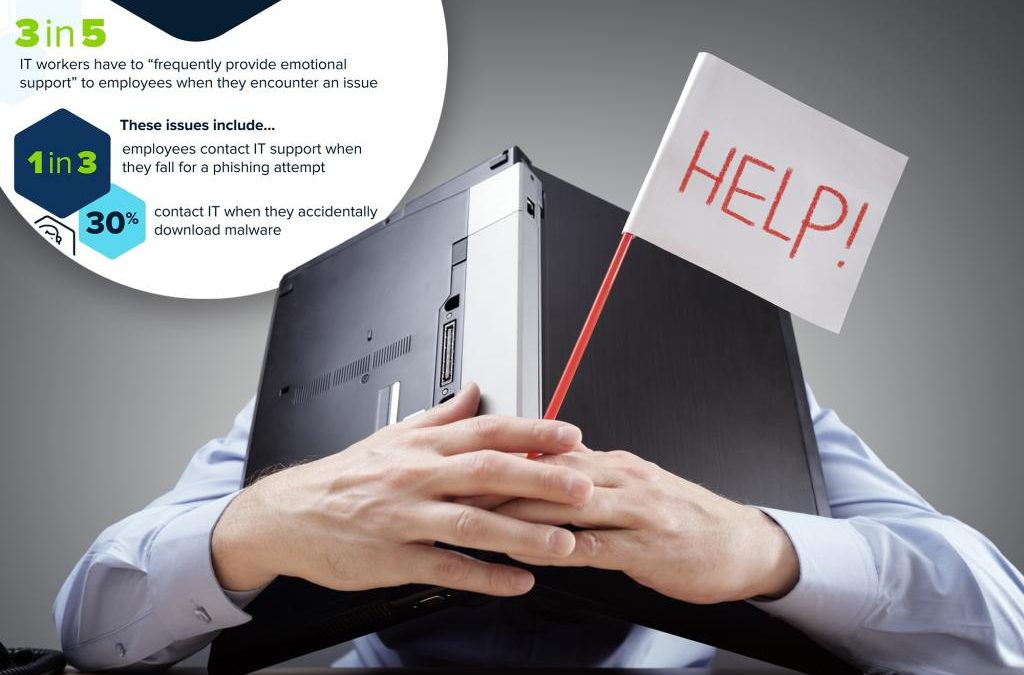IT help or therapist? A new survey has found three in five IT workers have to ‘frequently provide emotional support’ to users when they encounter a cybersecurity issue.
The poll of 2,000 US employees and IT workers revealed some of the most common accidents and mishaps employees have had with their work computers: spilling coffee or water on it (63%), spilling alcohol on it (63%), dropping it (45%) or falling for a phishing attempt (37%).
As a result, 59% of IT workers have to either “always” or “often” calm down users so they can explain what happened.
While cybersecurity threats are on the rise, four in five (79%) IT workers have a high level of trust that their organization’s users can identify and prevent cybersecurity threats themselves.
The feeling is mutual for 81% of employees who stated their IT team was prepared to deal with cybersecurity issues whenever they come up. This is likely due in part to regular cybersecurity education — 40% of IT respondents saying they require training monthly and another 25% offering it quarterly.
Commissioned by LogMeIn Rescue (a GoTo product) and conducted by OnePoll, research revealed despite seemingly being prepared, many still put off reaching out to IT.
An overwhelming majority of employees (94%) admitted they delay contacting IT, stating they will first try their own basic troubleshooting (62%) or be too embarrassed to admit what happened (52%).
Many shared the most common reasons they contact their organization’s support team: from being locked out of their email or computer (60%) to phishing attempts (48%) and internet issues (46%).
IT respondents reported that in more than 60% of these troubleshooting situations, they often or always rely on a remote support or remote access tool to resolve the end user’s issue.
IT workers agreed: they deal with email and computer lockouts most frequently (54%), followed by regularly dealing with forgotten passwords (41%) and complex issues with in-house software (30%).
An alarming 48% of employees reported seeing phishing attempts and 39% said that they have had to reach out to IT for a virus or malware issue on their computer.
“Our latest survey shows there’s a clear understanding and a symbiotic relationship between employees and IT departments – one simply can’t succeed without the other,” said Attila Törok, CISO at GoTo. “The strength of that relationship has become even more important in recent years as businesses have introduced new digital technologies, workers moved to a hybrid work model, and the threat of cyberattacks continues to grow.
“Today, we’re seeing a new level of partnership between IT and employees to resolve technology issues faster and keep their systems secure.”
The surveys, designed to ask employees and IT professionals separately how they interact with one another, found both groups largely see eye-to-eye on similar issues.
More than four in five (84%) employees said they are aware of how their IT team is supporting their businesses on a daily basis, and 85% in the IT field say they are aware of what users do on their work devices during the workday.
Eighty-four percent of employees find their IT department to be helpful and 76% said their IT team makes it easy to resolve tech-related issues.
Workers also generally find their IT team fast to fix issues — 31% said they tend to respond within an hour. Twenty-three percent said it only takes a couple of minutes, while 15% said the response time is immediate.
Meanwhile, IT workers said once a ticket is raised, they usually resolve issues within an hour (22%) or by the end of the workday (42%).
To get in touch with their IT department, many employees said it’s as easy as either sending them a direct message (70%), calling them (49%), emailing them (45%) or just walking to their department (40%).
“Investing in a strong IT stack is non-negotiable in the current work environment, but it’s just once piece of the puzzle,” continued Attila Törok. “Employees across the business must understand what IT does and how to work together effectively. Having easy access to your IT department and fostering positive relationships with the team are key to fixing problems fast and avoiding costly disruptions.”
Top 10 reasons people delay contacting IT
- They run their own basic troubleshooting first – 62%
- They’re embarrassed to admit what happened – 52%
- They need to see if the error is replicable or a one-off “glitch” – 40%
- They don’t think IT is helpful – 39%
- They don’t know how to reach IT – 38%
- They hope the issue will take care of itself – 38%
- They weren’t following the guidelines set by IT – 37%
- Their schedule is too busy – 32%
- It’s not a big enough priority for them – 24%
- They try to solve it themselves – 22%
Source




